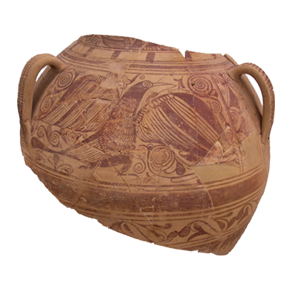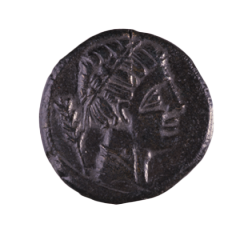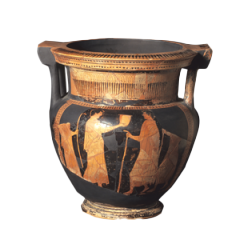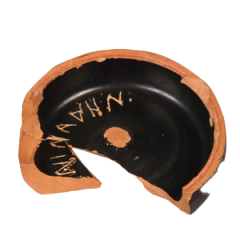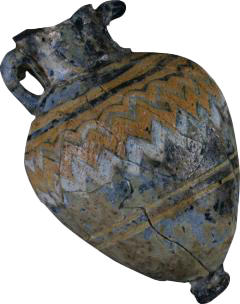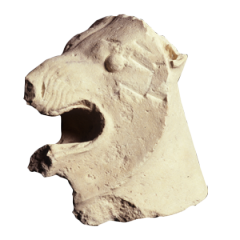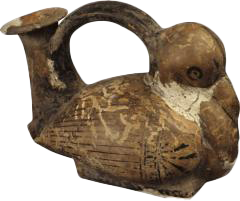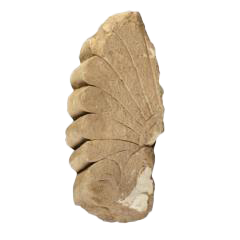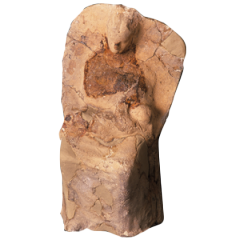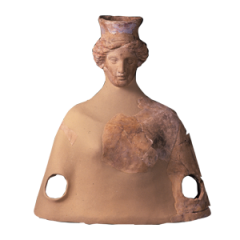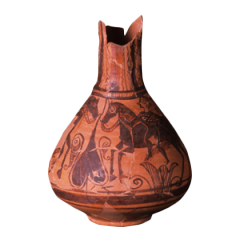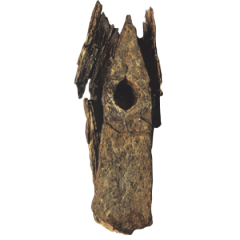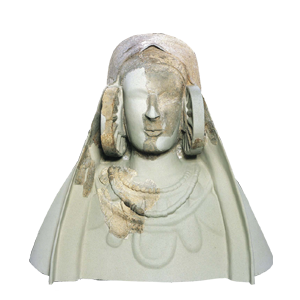
Lady of Cabezo Lucero
Necropolis of Cabezo Lucero (Guardamar del Segura, Alicante) Sandstone) Sandstone h: 49 cm; w: 54 cm; d: 33 cm Iberian End of the 5th century BC, beginning of the 4th century BC.
Sculpture reconstructed as a female bust in frontal position.
Based on the restoration criteria that were chosen at the time to present this new example of Iberian sculpture, we can indicate that there are two groups of fragments that give body to the proposed restitution. On the one hand, the head and the start of the neck with the elements of adornment and clothing that cover and embellish them and, on the other, the series of necklaces hanging from the chest. The two groupings of pieces do not touch each other by very little, although given the similarity of the stone, carving and place where they were found, there was no doubt that they were all part of the same sculpture.
The most damaged part of the head is the face. There were practically no facial features left in the block found. However, it was possible to attach fragments that gave shape to a little more than half of the face, mainly the left side. The forehead is slightly sloping, and the eye, which is very lost and marked with an incision, can be recognised as almond-shaped. The nose, the tip of which is missing, is straight and opens slightly to the flaps to define wide nostrils. The mouth is undulating and marked by fleshy lips. The chin, somewhat prominent, joins the start of the neck, which is suggested to be not very robust.
It is covered by a heavy-looking mantle because of the arched fold that crowns the forehead and opens from the buckles. The mantle covers a headdress, visible on the forehead. The upper decoration is completed by an ornament, which appears below the rim of the cap, consisting of a continuous series of semicircles. It is most probably a diadem.
The most striking elements, which immediately remind us of the "Dama de Elche", are the impellers, although more schematic than in the former, to hold the hair. The originals were probably made of sheet metal.
The other set that forms part of the reconstruction of the sculpture brings together the fragments of the chest covered by necklaces. A fine projection at the top indicates the neckline of the tunic, which suggests a rounded shape. On two of the necklaces hang medallions that would represent pieces of gold or silver in the shape of a reed, strung by what would be metal cords or rings. Of the other two necklaces, whose models would be made of vitreous paste, the upper one is made up of olive-shaped, spherical and flat beads; the lower one shows pairs of disc-shaped beads between which are placed others in the shape of tonelete beads. The "Lady of Cabezo Lucero" was destroyed in the Iberian period, as were other sculptures from the site, some fragments of which were used as wedges for cinerary urns in some tombs. This "iconoclastic" phenomenon, which has become more nuanced in recent research, has been detected in other cemeteries and was perhaps caused by social upheavals or changes in ritual at the end of the 5th century BC and the beginning of the 4th century BC.
Regardless of whether it was originally a bust, there are undeniable features that link it to the most famous of Iberian sculptures. This highlights several considerations. Firstly, that the "Lady of Elche" is not a suspicious or clearly false unicum, as a North American author claimed some years ago. The fact that the Guardamar sculpture was found in a scientific archaeological excavation and in a place close to the Elche sculpture is enough to dispel any doubts about the antiquity of the latter. The geographical proximity of both pieces, in addition to other examples that are not dealt with here, leads us to think that there was a definite sculptural circle in the area of the present-day regions of Bajo Vinalopó and Bajo Segura, which would ultimately be a form of expression of a homogeneous cultural environment in the south of the Iberian Contestania.
S.C.: 6108.
LLOBREGAT, E. and JODIN, A., 1990.
ARANEGUI, C. et alii, 1993.
Outstanding pieces in the Iberian Hall
- TINAJA CON DECORACIÓN
ESTILO ELCHE-ARCHENA
Tossal de la Cala (Finestrat).
Cerámica
h: 39 cm; a: 46 cm; e: 30 cm
Iberian
Siglos II-I a.C. - ................................................. Bronze ace from the Iberian mint of Saiti (Xàtiva, Valencia). Type Vives 20-2.
- ................................................. Necropolis of El Cabezo Lucero (Guardamar del Segura) Ceramic h: 34'5cm; w: 29'5 cm Iberian 460-450 BC.
- ................................................. Illeta dels Banyets (El Campello) Ceramic h: 11.2 cm; w: 11.2 cm; d: 2.9 cm Iberian. 380-325 BC.
- ................................................. Necropolis of Cabezo Lucero (Guardamar del Segura) Vitreous paste h: 6.5 cm; w: 4.1 cm: 4'1 cm Ancient Iberian Late 5th century BC.
- ................................................. Necropolis of Cabezo Lucero (Guardamar del Segura, Alicante) Limestone h: 27.5 cm; w: 19 cm; d: 23 cm Iberian Second half of the 5th century - beginning of the 4th century BC.
- ................................................. Necropolis of Cabezo Lucero (Guardamar del Segura)
- ................................................. Necropolis of Cabezo Lucero (Guardamar del Segura) Limestone h: 18.5 cm; w: 8.5 cm; d: 5.3 cm Ancient Iberian-Pliocene Second half of the 5th century-early 4th century BC.
- ................................................. DEMETER-LIKE MOTHER-GODDESS Necropolis of La Albufereta (Alicante) Ceramic made with a univalve mould h: 21 cm; w: 11.3 cm; h: 7.5 cm Iberian 4th century BC.
- Terracotta bust ................................................. Necropolis of La Albufereta (Alicante) Terracotta h: 40 cm; w: 37 cm; d: 21.5 cm Iberian 4th-3rd century BC: 37 cm; w: 21'5 cm Iberian 4th-3rd century BC.
- ................................................. Tossal de Manises (Alicante) Ceramic h: 31.5 cm; w: 21.4 cm Iberian Late 3rd century BC.
- ............................................. La Escuera (San Fulgencio) Iron h: 30 cm; w: 11.4 cm; h: 13.8 cm Iberian 3rd century BC.
- ................................................. Necropolis of Cabezo Lucero (Guardamar del Segura, Alicante) Sandstone) Sandstone h: 49 cm; w: 54 cm; d: 33 cm Iberian Late 5th century BC, early 4th century BC.

